- Skip to main content
IELTS Podcast
Pass IELTS with expert help.

Line graph example
Ielts line graph sample essay.
Home » IELTS academic task 1 » Line Graph Sample Essay
Line graphs come up often in IELTS writing part 1. We will show you how to confidently answer questions about line graphs, helping you practice summarising the data and identifying trends.
For each line graph (or line chart) question, you will need to summarise the information by selecting and reporting the main features and make comparisons where relevant. You should write at least 150 words. To make the best use of your time it’s important to write with a clear structure, focus on the most important trend or trends, choose appropriate vocabulary and avoid common mistakes.
In this tutorial, we have a band range 6.5 / 7 academic task 1 IELTS line graph example essay graded by an ex-IELTS examiner (on our team of essay correctors). There are some great examples of useful feedback to help you improve your own line chart answers.
This line graph tutorial will help you:
- Choose the right information
- Use the right sentence structures
- Decide on the perfect tense to use
Each criteria has been considered and r eviewed by one of the ex-IELTS examiners on our team. T he different sentences in the essay have been colour coded to correspond to the four marking criteria used by the British Council / IELTS IDP . At the IELTS podcast website, we also have an amazing essay correction service if you need help with your IELTS writing, so this is an example of the personalised feedback you could receive.
Make sure you understand what the codes mean:
- TR means task response – have you summarised the main information and made comparisons?
- CC is coherence and cohesion (does your essay ‘flow’ well, does it make sense?)
- LR is lexical resource (or vocabulary)
- GR means grammar
Therefore TR1 is the first comment about Task Response.
Example line graph question:
The line graph shows the average rainfall for three countries in Great Britain over a 12 month period in 2018. Summarise the information by selecting and reporting the main features, and make comparisons where relevant. Write at least 150 words
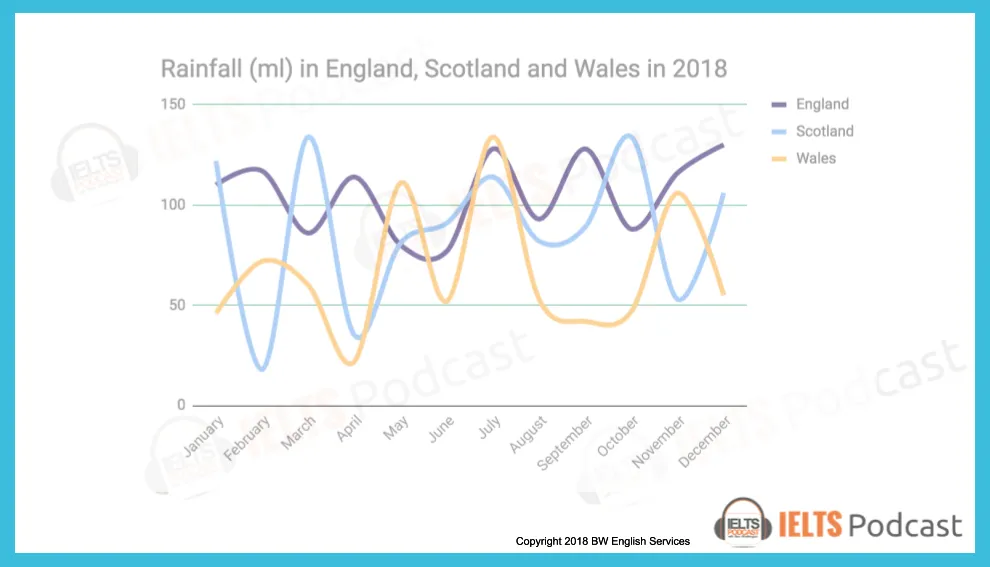
The line graph reveals the information of rainfall in three countries: England, Scotland, and Wales for one year starting from January to December in 2018.
In England, the amount of rainfall in January was recorded just above 100ml, which slightly increased in the next month by 5ml, and dipped to 90ml in March. The trend of raising and falling continue for a couple of months and reached its lowest figure in the graph for the month of June at around 70ml. After that, it is predicted that the level of rain will fluctuate and will remain around 120ml in December.
In Scotland, the amount of rain in January was 125ml, dropped unexpectedly to its lowest level to 20ml in February, and rocketed in next month to its peak value of 135ml. In April, the amounts of rain were less than 50ml, then start went up slightly until June. Then after it is predicted to drop until September, the following month it will start climbing up to October, and it will be decreased to 50 ml before reaching to 105 ml in December.
In wales, the rainfall was 50ml in January increased slightly in February and decreased to its lowest point in April around 30ml. In next month went up sharply to 110ml and dipped by 50ml in June. It is predicted that the highest amount of rain will be in July at 125ml and went down just below the month of June’s record. It will remain constant for two months before reaching 105ml in November and it will dip down in December to 52ml.
Overall it can be clearly seen that in each country the amount of rain in January will be approximately same in the month of December.
Let’s look at the essay above with ex-IELTS examiner commentary on each section.
The line graph reveals the information of rainfall (LR1) in three countries: England, Scotland, and Wales for one year starting from January to December in 2018.
TR1 – A good opening paragraph. Effective use of paraphrasing and you have included the key information.
LR1 – This could sound more natural. Perhaps ‘shows information about rainfall’, ‘shows rainfall statistics’ or ‘shows how much rain fell…’?
In England (TR2), the amount of the rainfall (GR1) in January was recorded just above 100ml, which slightly increased in next month by 5ml, and dipped to 90ml in March. The trend of raising (LR2) and falling continue (GR2) for a couple of months and reached its lowest figure in the graph for the month of June at around 70ml. After that, it is predicted that the level of rain will fluctuate and will remain (TR3) / (GR3) around 120ml in December.
TR2 – Good to adopt a systematic approach to presenting the information
GR1 – the amount of rainfall
LR2 – Check the difference between ‘rise’ and ‘raise’. GR2 – continued
TR3 – Make sure you report the information accurately.
GR3 – Stick to using past tenses here as all the information relates to 2018
In Scotland, the amount of rain in January was 125ml, dropped (CC1) unexpectedly to its lowest level to 20ml (CC2) in February, and rocketed (LR3) in next month (GR4) to its peak value (LR3) of 135ml. In April, the amounts of rain were less than 50ml, then start went up (GR5) slightly until June. Then after (CC3) it is predicted to drop until September, the following month it will start climbing up to October, and it will be decreased (TR4) / (GR6) to 50 ml before reaching to 105 ml (LR4) in December.
CC1 – You need to link your ideas together in an appropriate way. Perhaps ‘125ml, and this figure dropped…’?
CC2 – As before. Perhaps ‘… to its lowest level, 20 ml, in February’?
LR3 – Accurate use of some key language to describe graphs.
GR4 – in the next month GR5 – started to go up
CC3 – Take care with your use of linking words.
TR4 – As with the previous paragraph, make sure you report the information correctly.
GR6 – Stick to using past tenses as all the information relates to 2018.
LR4 – Omit the ‘to’ – ‘… reaching 105ml…’
In wales (GR7), the rainfall was 50ml in January increased (CC4) slightly in February and decreased to its lowest point in April (LR5) around 30ml. In next month went up sharply to 110ml and dipped (LR6) by 50ml in June. It is predicted that the highest amount of rain will be in July (TR5) / (GR8) at 125ml and went down just below the month of June’s record. It will remain constant (LR7) for two months before reaching 105ml in November and it will dip down in December to 52ml.
GR7 – Take care with your use of punctuation. Use a capital letter for the name of a country.
CC4 – You need to be careful with the way you link your ideas together. Perhaps ‘… in January and this figure increased…’?
LR5 – Very natural use of language.
LR6 – Good to incorporate a wide range of appropriate vocabulary.
TR5 – As before, you need to report the information accurately.
GR8 – As in the previous paragraphs, this is an inappropriate use of tenses.
LR7 – Despite the problems with tenses, this vocabulary is appropriately selected.
Overall it can be clearly seen that (CC5) in each country the amount of rain in January will be (TR6) / (GR9) approximately same in the month of December. (TR7)
CC5 – On the right track to introduce the main features of the graph.
TR6 – As before, there are problems with task achievement.
GR9 – Inappropriate use of tenses.
TR7 – I think this paragraph is intended to be your overview? If so, this would be a useful area to work on as it is one of the key differences between a ‘6’ and a ‘7’ for task achievement.
PROBABLE IELTS SCORE: 6.5 / 7.0
Some final practical advice for answering line chart questions in your IELTS test:
- Do not start writing before giving yourself enough time to think. First decide the language you will need in your answer. Give yourself 5 minutes to look, think and plan.
- Study the line graph carefully: be clear about the topic and what each line represents.
- The labels on the axes will give you useful information. Look at the horizontal axis to understand the period of time shown, and the vertical or x axis to see how the data is shown (in centimetres, in dollars, in millions?)
- Check the time frames very carefully in the line and plan how time differences will affect your choice of verb tenses.
- What is the main trend or trends?
- The easiest way to make comparisons is by using superlatives in your answer. For example: comparing the largest and smallest amounts of rainfall by country or comparing the least and most expensive products over time.
- Say how two or more lines are related – do they both increase over time? Are any points connected?
- Finally, make sure you have included an overview!
Audio tutorial with transcript
You can download or listen to the audio version here:
| Direct Download Here | Stitcher | iTunes | Spotify | Soundcloud | Transcript |
IELTS task 1 line graph video tutorial
More useful IELTS Academic Task 1 lessons:
- Academic Task 1 Sample Essays
- How to describe a pie chart
- Bar Chart IELTS
- How to describe a map
- Describe an image
- Describe a natural process
- How to describe a table
- How to paraphrase
- Line graph sample answer
- Marking criteria for Task 1
- Map vocabulary for IELTS Task 1
- How to describe a flow chart
- Essential skills for Task 1
- How to get band 9 for academic task 1
- How to describe a process diagram
Podcast: Play in new window | Download

- Ebooks & Courses
- Practice Tests
How To Write an IELTS Line Graph Essay
Here is the 5 steps process I recommend for planning and writing IELTS line graph essays:
1) Analyse the question
2) Identify the main features
3) Write an introduction
4) Write an overview
5) Write the details paragraphs
I’m going to take you through the whole process step-by-step as we work on a practice question.
Many students are reluctant to spend time on steps 1 and 2 as they want to spend as much of the 20 minutes allowed for the essay as possible actually writing it. However, it is essential that you do them as they are the key to writing a high-scoring IELTS line graph essay.
Before we begin, here’s a model essay structure that you can use as a guideline for all IELTS Academic Task 1 questions.
Ideally, your essay should have 4 paragraphs:
Paragraph 1 – Introduction
Paragraph 2 – Overview
Paragraph 3 – 1 st main feature
Paragraph 4 – 2 nd main feature
Now that we have all these tools we need, we’re ready to begin planning and writing our IELTS line graph essay.
Here’s our practice question:
The graph below shows radio and television audiences throughout the day in 1992.
Summarise the information by selecting and reporting the main features, and make comparisons where relevant.
Write at least 150 words.
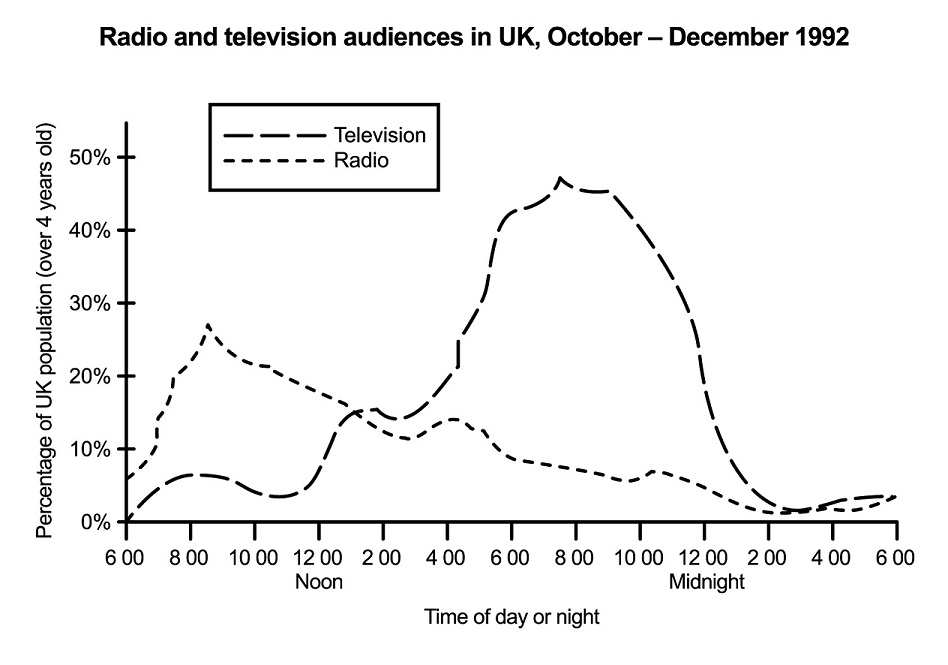
Source: Official IELTS website
Step 1 – Analyse the question
The format of every Academic Task 1 question is the same. Here is our practice question again with the words that will be included in all questions highlighted .
The graph below shows radio and television audiences throughout the day in 1992.
Every question consists of:
- Sentence 1 – A brief description of the graphic
- Sentence 2 – The instructions
- The graphic – chart, graph, table, etc.
Sentence 2 tells you what you have to do.
You must do 3 things:
1. Select the main features.
2. Write about the main features.
3. Compare the main features.
All three tasks refer to the ‘ main features ’ of the graphic. You do not have to write about everything. Just pick out 2 or 3 key features and you’ll have plenty to write about.
Step 2 – Identify the Main Features
The graphic in IELTS line graph questions should not be difficult to interpret. Each question has been created to test your language skills, not your mathematics ability.
All you are looking for are the main features. These will usually be the easiest things to spot. There will be lots of information in the graphic to help you identify them.
Here are some useful questions to ask?
- What information do the 2 axes give?
- What are the units of measurements?
- What are the time periods?
- What can you learn from the title and any labels?
- What is the most obvious trend?
- Are there any notable similarities?
(I give more detail on how to use these questions, plus downloadable checklists for identifying the main features of all 7 different types of IELTS Academic Writing Task 1 questions, in the lesson on How To Understand & Analyse Task 1 Questions .)
So, what main features stand out in our practice graphic?
Here's our IELTS line graph again.

The timeline will give you the biggest clues as to the most significant trends. Look for general trends.
There are 2 main features/trends in this line graph:
Main feature 1: The peak time for TV audiences is in the evening (8 pm).
Main feature 2: The peak time for radio audiences is in the morning (8 am).
The general trends you select will be the starting point for your essay. You will then go on to add more detail. However, with just 20 minutes allowed for Task 1, and a requirement of only 150 words, you won't be able to include many details.
We’re now ready to begin writing our essay. Here’s a reminder of the 4 part structure we’re going to use.
Step 3 – Write an Introduction
In the introduction, you should simply paraphrase the question, that is, say the same thing in a different way. You can do this by using synonyms and changing the sentence structure. For example:
Introduction (Paragraph 1):
The line graph illustrates the proportion of people in the UK who watched TV and listened to the radio over 24 hours from October to December 1992.
This is all you need to do for the introduction.
Step 4 – Write an Overview (Paragraph 2)
In the second paragraph, you should report the main features you can see in the graph, giving only general information. The detail comes later in the essay. You should also make any clear comparisons you spot.
This is where we write about the general trends. Here are the ones we picked out above.
Now form these ideas into two or three sentences with a total of around 40 words. State the information simply using synonyms where possible. No elaborate vocabulary or grammar structures are required, just the appropriate words and correct verb tenses.
For example:
Overview (Paragraph 2):
Overall, a significantly greater percentage of the TV audience watched in the evening while radio had the most listeners in the morning. Over the course of each day and night, more people watched TV than listened to the radio.
Step 5 – Write the 1st Detail Paragraph
Paragraphs 3 and 4 of your IELTS line graph essay are where you include more detailed information about the data in the graphic. In paragraph 3, you should give evidence to support your first key feature. Don’t forget to make comparisons when relevant.
Here is our first main feature again:
And this is an example of what you could write:
Paragraph 3 :
Less than 10% of people watched TV between 1 am and 12 noon but at 4 pm this figure increased rapidly, reaching a peak of almost half the population at 8 pm. After this, the graph records a sharp decline in viewers, reaching a low of only a tiny percentage by 3 am.
Step 6 – Write the 2nd Detail Paragraph
For the fourth and final paragraph, you do the same thing for your second key feature.
Here’s an example of what you could write:
Paragraph 4 :
Radio, on the other hand, shows a very different trend. The most popular time for listeners to be tuned in was just after 8 am when around 27% of the population was listening. After a brief peak, the numbers dropped steadily to barely 2%, apart from fluctuations at around 4 pm and 10.30 pm. The percentage of listeners remained low overnight before beginning a rapid ascent from 6 am to the 8 am high.
Here are the four paragraphs brought together to create our finished essay.
Finished IELTS Line Graph Essay
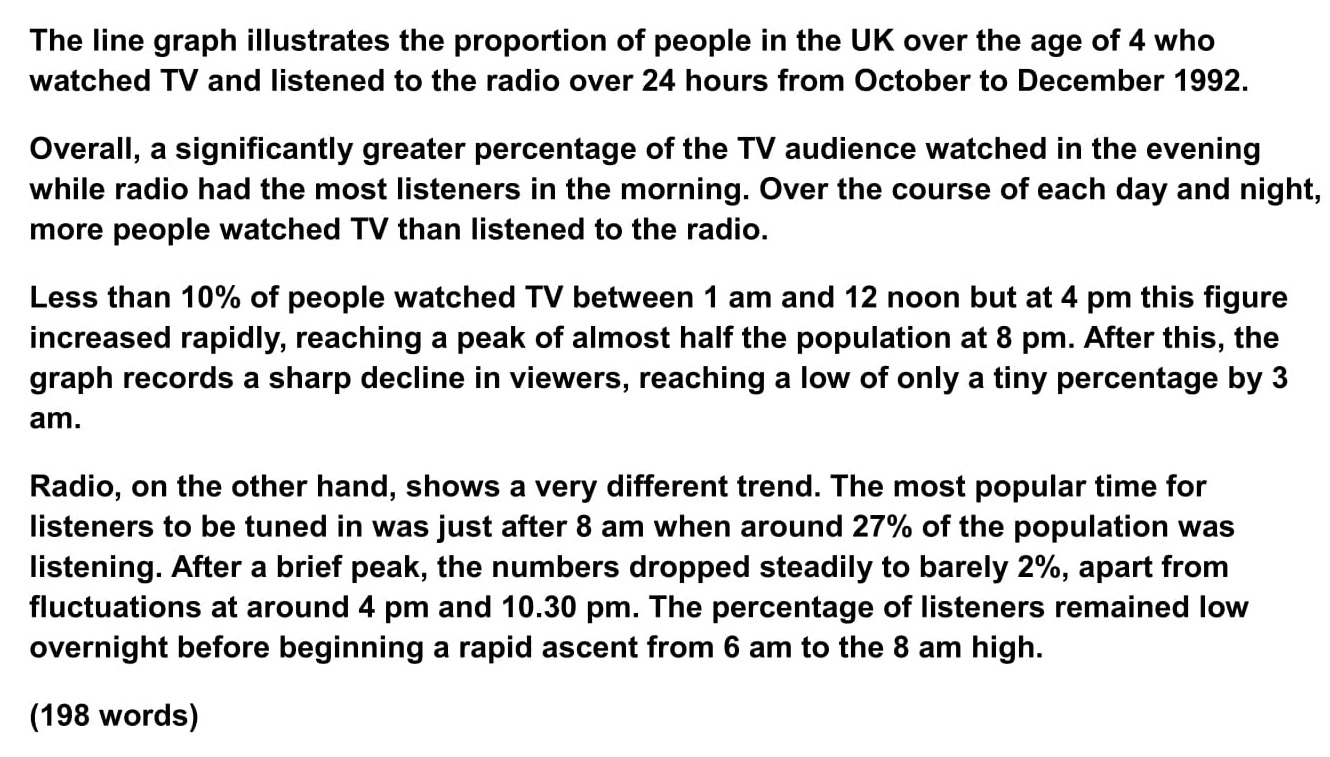
This sample IELTS line graph essay is well over the minimum word limit so you can see that you don’t have space to include very much detail at all. That’s why it is essential to select just a couple of main features to write about.
Now use what you’ve learnt in this lesson to practice answering other IELTS line graph questions. Start slowly at first and keep practicing until you can plan and write a complete essay in around 20 minutes.
Want to watch and listen to this lesson?
Click on this video.
Would you prefer to share this page with others by linking to it?
- Click on the HTML link code below.
- Copy and paste it, adding a note of your own, into your blog, a Web page, forums, a blog comment, your Facebook account, or anywhere that someone would find this page valuable.
Like this page?
Ielts academic writing task 1 – all lessons.
IELTS Academic Writing – A summary of the test including important facts, test format & assessment.
Academic Writing Task 1 – The format, the 7 question types & sample questions, assessment & marking criteria. All the key information you need to know.
Understanding Task 1 Questions – How to quickly and easily analyse and understand IELTS Writing Task 2 questions.
How To Plan a Task 1 Essay – Discover 3 reasons why you must plan, the 4 simple steps of essay planning and learn a simple 4 part essay structure.
Vocabulary for Task 1 Essays – Learn key vocabulary for a high-scoring essay. Word lists & a downloadable PDF.
Grammar for Task 1 Essays – Essential grammar for Task 1 Academic essays including, verb tenses, key sentence structures, articles & prepositions.
The 7 Question Types:
Click the links below for a step-by-step lesson on each type of Task 1 question.
- Table Chart
- Process Diagram
- Multiple Graphs
- IELTS Writing
- IELTS Line Graph
- Back To Top
* New * Grammar For IELTS Ebooks

$9.99 each Full Set Just $ 23.97
Find Out More >>
IELTS Courses

Full details...

IELTS Writing Ebook

Discount Offer
$7 each Full Set Just $ 21

Find out more >>
Testimonials
“I am very excited to have found such fabulous and detailed content. I commend your good work.” Jose M.
“Thanks for the amazing videos. These are ‘to the point’, short videos, beautifully explained with practical examples." Adari J.
"Hi Jacky, I bought a listening book from you this morning. You know what? I’m 100% satisfied. It’s super helpful. If I’d had the chance to read this book 7 years ago, my job would be very different now." Loi H.
"Hi Jacky, I recently got my IELTS results and I was pleased to discover that I got an 8.5 score. I'm firmly convinced your website and your videos played a strategic role in my preparation. I was able to improve my writing skills thanks to the effective method you provide. I also only relied on your tips regarding the reading section and I was able to get a 9! Thank you very much." Giano
“After listening to your videos, I knew I had to ditch every other IELTS tutor I'd been listening to. Your explanations are clear and easy to understand. Anyways, I took the test a few weeks ago and my result came back: Speaking 7, listening 9, Reading 8.5 and Writing 7 with an average band score of 8. Thanks, IELTS Jacky." Laide Z.
Contact
About Me
Site Map
Privacy Policy
Disclaimer
IELTS changes lives.
Let's work together so it changes yours too.
Copyright © 2024 IELT Jacky
All Right Reserved
IELTS is a registered trademark of the University of Cambridge, the British Council, and IDP Education Australia. This site and its owners are not affiliated, approved or endorsed by the University of Cambridge ESOL, the British Council, and IDP Education Australia.
- Introduction
Writing - Graph

- 500+ Essays, Letters, Graphs & Model Answers
- Plan routine with our Study Planner
- Improve vocabulary with Vocab Bank

- IELTS Academic Writing Task 1: Describing Graphs, Tables, Charts, Processes, and Maps
In the first part of IELTS Academic Writing, you can come across different types of graphs: a line or bar graph, a table, a map, a process, two graphs or two tables.

You select words and grammatical constructions depending on the type of graph you are writing about. For example, if you got a process (e.g. water cycle on Earth) you use words such as: first, following this, the next stage, then ... etc. For a table, such words are not the best idea.
1. Bar Chart
You should spend about 20 minutes on this task.
The bar chart shows the global sales (in billions of dollars) of different types of digital games between 2000 and 2006.
Summarise the information by selecting and reporting the main features, and make comparisons where relevant. Write at least 150 words.

In the task, only the part in bold changes.

There may be two tables:

The description of tables is very similar to the description of graphs. We use the same language of comparison and contrast. The table can be easily turned into a bar chart, but the information is better presented with the table: we immediately see the similarities and differences. We should try to group this information. For example, in case where there are several different countries, they can be combined as developed and developing countries. So, you do not have to write about each country separately.
3. Line Graph

4. Pie Chart
The pie charts compare the expenditure of a school in the UK in three different years over a 20-year period.

We structure the answer as follows: Firstly, we write about the largest parts (40%, 50%, 45%), then we cover those that are slightly smaller (28%, 22%, 23%), etc. 8% and 9% - can be combined. We do not write about each chart separately. We take one category in the first graph and compare it with other graphs - what is the same and what is different.
Sometimes there could be a description of a process OR a life cycle of an animal or insect; and you must be prepared for this. The structure is similar to the rest of the tasks: - Introduction (rephrase the assignment) - The main part (Here we write about the stages / steps of the process and use the passive voice (e.g. water is evaporated) - Conclusion (give an overview, i.e. something in common about the process). For example, how many stages there are, or how the process begins and ends:
Overall, there are eight stages in the process, beginning with the digging up of clay and culminating in delivery.
Process example
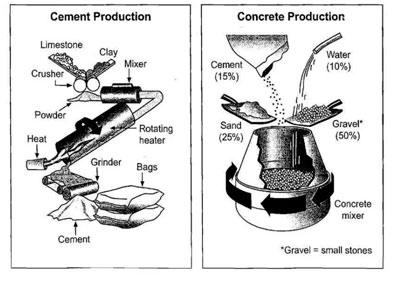
In the latest tests people have been coming across tasks with 2 maps. The examiners say that the maps description answers are weaker than the graphs description because, apparently, everyone is diligently preparing for the graphs and ignoring maps: “Since there is a small chance that I come across map description, It is not necessary to prepare for it”. It is necessary) Here in the main part we write about the main changes that have occurred: what was built + where. You can add why it was built. To add more details, you can write about what was / wasn’t there before.
Maps Examples
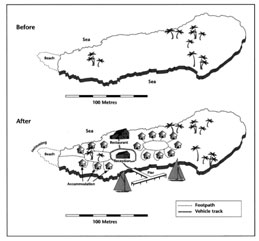
7. Two Graphs (2 tables, a chart and a table or 3 pie charts)
The graph and table below give information about water use worldwide and water consumption in two different countries.
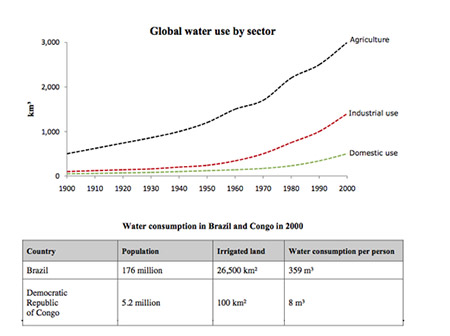
With this one it is very important to choose the information about which one you are going to write. You don’t need to write about everything! You can choose the most basic information. After you rephrase the assignment in the introduction, you can write about the first chart. In the next paragraph, you can write about the second. This way you will not get confused, and it will be easy for the examiner to read your answer. In conclusion, you can show how the two graphs are connected.
How to master IELTS Writing: Task 1 & Task 2
- How to write an answer to ANY type of Essay task
- How to write an answer to ANY type of Graph task
- How to structure your answer
- What to write in each paragraph
- What grammar to use
- How to link your ideas
- What vocabulary to use
- What you should write to get a high score
Bonus: IELTS Punctuation PDF Guide Everything you want to know to have correct punctuation in your IELTS Writing for 7.0-9.0 Score (31 pages, .PDF)
- You are here:
- Prepare for IELTS
- IELTS Writing
- Academic Task 1
- How to check IELTS Results
- IELTS Academic and IELTS General: differences and similarities
- Computer delivered IELTS
- IELTS Band Scores and English levels comparison chart
- IELTS Exam: Test structure and Format
- Essay Structure
- Detailed Analysis
- Academic Task 2
- IELTS Vocabulary
- IELTS Listening
- IELTS Reading
- IELTS Speaking
- IELTS Writing Course
- Punctuation Guide
- Teacher Training: How to Teach IELTS
- Teacher Training: IELTS Writing for Teachers
- IELTS Training Sessions for Teachers
- Master IELTS General: Letters
IELTS Preparation with Liz: Free IELTS Tips and Lessons, 2024
- Test Information FAQ
- Band Scores
- IELTS Candidate Success Tips
- Computer IELTS: Pros & Cons
- How to Prepare
- Useful Links & Resources
- Recommended Books
- Writing Task 1
- Writing Task 2
- Speaking Part 1 Topics
- Speaking Part 2 Topics
- Speaking Part 3 Topics
- 100 Essay Questions
- On The Day Tips
- Top Results
- Advanced IELTS
IELTS Sample Charts for Writing Task 1 Practice
Below are sample IELTS charts to practise writing task 1 at home. In the IELTS writing task 1 (academic paper), you will be given one of the following and will have 20 mins to write a full report:
- diagram or process
- combination of the above (multiple tasks)
This collection of IELTS charts represents the main types of charts that you can be given in writing task 1, including tasks with two or three charts combined. Please remember that writing task 1 is not an essay, it is a report.
Use the sample practice charts, tables and diagrams below to practise and develop your IELTS writing task 1. Some charts below have links to model answers. Charts not created by myself have the known source stated when possible.
Practice Charts for IELTS Writing Task 1
You must write a report of over 150 words You have 20 mins for this task
IELTS Bar Chart Practice Samples
The bar chart below shows the percentage of people who ate five portions of fruit and vegetables per day in the UK from 2001 to 2008.
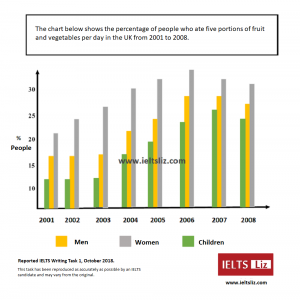
- Source: IELTS Liz, Reported by IELTS Candidate
- Download: IELTS Writing task 1 October 2018
- Model Answer: Answer
The bar chart below shows the hours per week that teenagers spend doing certain activities in Chester from 2002 to 2007.
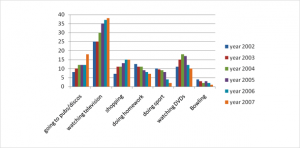
- Source: English-in-Chester
The chart below shows the global sales of different kinds of digital games from 2000 to 2006.
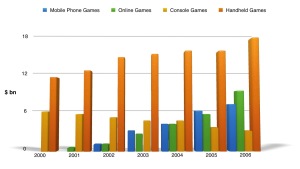
- Source: Chart not by IELTS Liz. Source unknown.
IELTS Line Graph Practice Samples
The graph below shows the population figures for different type of turtles in India from 1980 to 2012.

- Source: Graph not designed by IELTS Liz. Source unknown.
The graph below shows the amount of goods transported in the UK from 1974 to 2002.

- Source: IELTS Cambridge English Test Books
- Useful Tips: Tips
The line graph below shows the consumption of 4 kinds of meat in a European country from 1979 to 2004.

IELTS Table Practice Samples
The table below shows the proportion of income spent on 4 common items in the UK in 1998.

- Source: Table not designed by IELTS Liz. Source unknown

- Source: IELTS Liz, Reported by IELTS candidate
The table below gives information about the underground railway systems in 6 countries.

The table below shows consumer spending on different items in 5 countries in 2002.

The table below gives information about the employment sectors in which people from 3 age groups worked.

IELTS Pie Chart Practice Samples
The pie charts below show the average household expenditures in a county in 1950 and 2010.
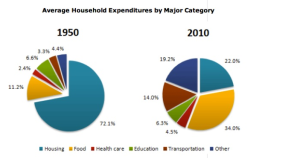
- Source: Charts not designed by IELTS Liz. Source unknown.
The charts below show the percentage of students joining North West University.

The charts below give information about the electricity generation in two countries in 2009.

The pie charts below show the spending of a school in the UK from 1981 to 2001.
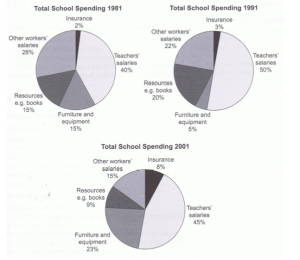
IELTS Diagram Practice Samples
The diagram below shows how rainwater is collected for the use of drinking water in an Australian town.
The diagram below shows the water supply in Australia at present and in the future.
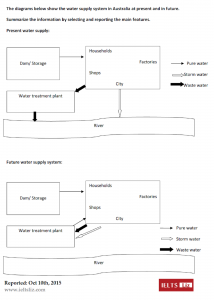
The diagram below shows how the water cycle works.

- Source: New Insight into IELTS
- Although this book was published years ago, I still recommend it for practise at home.
The diagram shows the process of making coffee.
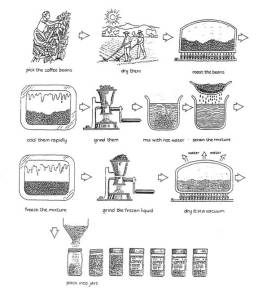
- Source: Diagram not designed by IELTS Liz. Source unknown.
The diagram below shows how coal is used to generate electricity.
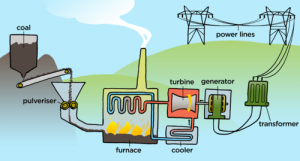
- Source: mstworkbooks.co.za , natural sciences.
IELTS Map Practice Sample
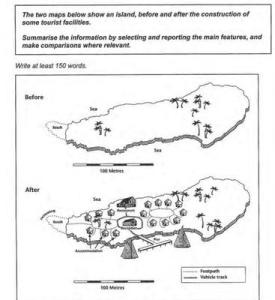
IELTS Multiple Charts Practice Samples
Two Bar Charts
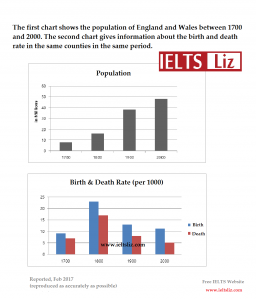
- Download PDF: IELTS 2017 Writing Task 1
Bar Chart & Two Pie Charts The charts below give information about levels of education in Glasgow, a city in Scotland, in 2010.
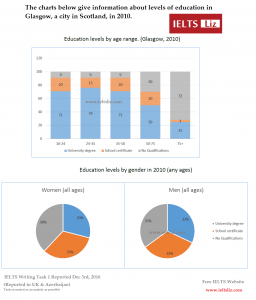
Table & 3 Pie Charts

Two Pie Charts & Bar Chart
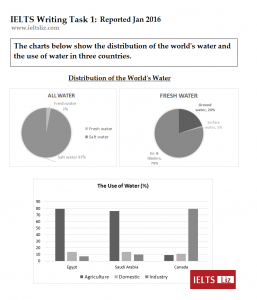
Useful Links for Free IELTS Preparatio
IELTS Writing Task 1: Tips, Answers, Vocabulary & Videos
IELTS Writing Task 2: Model Essays, Linking Words & Videos
All the best
Advanced IELTS Lessons & E-books

Click Below to Learn:
- IELTS Test Information
Copyright Notice
Copyright © Elizabeth Ferguson, 2014 – 2024
All rights reserved.
Privacy Policy & Disclaimer
- Click here: Privacy Policy
- Click here: Disclaimer
Return to top of page
Copyright © 2024 · Prose on Genesis Framework · WordPress · Log in
- A Beginner’s Guide to IELTS
- Common Grammar Mistakes [for IELTS Writing Candidates]
Writing Correction Service
- Free IELTS Resources
- Practice Speaking Test
Select Page
How to Describe a Graph
Posted by David S. Wills | Oct 31, 2022 | IELTS Tips , Writing | 2
In IELTS writing task 1, you will be asked to describe some sort of visual data. It could be a line graph, a bar chart, a table , a map , a pie chart, or a process diagram . ( Here’s a full list.) In this article, we’re going to ignore some of these and look at how to describe a graph .
I will give you some important advice about how to analyse the data, use the right language, and structure your answer.
Note: This is a general guide to describing graphs. If you want specific instructions for each kind of graph or chart, then please see the following guides:
- How to describe a line graph
- How to describe a pie chart
- How to describe a bar chart
Analysing the Graph
When you are given a graph to describe, you need to take a moment to understand what you are looking at. Don’t rush this. In IELTS, it should be pretty obvious what you are given because the only three graph types you have are:
- Line graphs
However, you may have a graph that incorporates the first two or you could be given a line graph and a table, a bar chart and a pie chart, or any combination thereof.
Recognising the type of graph you are given is important because they serve different functions and usually require different language to describe. It’s pretty obvious what they are:
As for their functions, typically they do the following:
- Line graphs show changes in values over time.
- Bar charts compare different types of data.
- Pie charts show a proportion of a whole value.
Of these, bar charts probably have the most diverse array of functions and can therefore be the hardest to describe, but that’s not always the case. It totally depends on what is in the data, so analyse it carefully.
Keep in mind that bar charts may present data from different points in time (like a graph does) but that the data may all come from a single point in time. There can also be various types of data included, so don’t jump to conclusions.
Choosing the Right Language
If you want to know how to describe a graph, then you need to know the right type of language to use. Of course, that will largely depend on the data in the graph. You will need different vocabulary for prices, populations, interest rates, and so on.
You also need to use grammar carefully because picking the wrong verb tense could really confuse your reader. Thus, pay attention to any clues about time. Ask yourself:
- Is this data from the past, present, or future?
- Does it all come from the same point in time?
- Is it a prediction?
All of that will impact your description. For example, look at these three bar charts:
They all look the same, right? But each one shows a different period of time , so they would require totally different grammar.
- Bar chart 1 shows information from the past.
- Bar chart 2 shows information from the past and present
- Bar chart 3 shows information that includes future predictions
Thus, we would use different verb tenses:
- The price of corn rose from $5 in 2000 to $18 in 2015.
- The price of corn has risen from $5 in 2000 to $18.
- The price of corn rose from $5 in 2000 to $15 in 2020 and is expected to rise to $18.
You can see that for bar chart 1 I used the past simple tense. For bar chart 2, I used the present perfect. Then, for bar chart 3 I used the past simple and also a speculative future term: “is expected to.”
Further reading:
- Avoiding vague language for task 1
- How to use the present perfect tense
- Past perfect vs present perfect
Structuring your Graph Description
For IELTS writing task 1, you need to group your data intelligently. However, there is no prescribed formula for this. In other words, there are different ways to structure your task 1 essays.
You do, however, need to include a few things:
- An introduction that tells the reader what you are describing.
- An overview of the data (for example, a main trend).
- A detailed description of the main features.
Here are some things that you don’t need to include:
- Too much information.
- A conclusion.
I generally structure my task 1 reports like this:
Of course, this is hard to generalise because every graph is different. Sometimes you might have just one body paragraph and sometimes you might have three. You shouldn’t write too much, though, and don’t fragment your description to the point where there are lots of paragraphs or else you will not succeed in terms of Coherence and Cohesion .
You might appreciate these related resources:
- How to structure a task 1 essay
- A guide to grouping data for task 1
About The Author
David S. Wills
David S. Wills is the author of Scientologist! William S. Burroughs and the 'Weird Cult' and the founder/editor of Beatdom literary journal. He lives and works in rural Cambodia and loves to travel. He has worked as an IELTS tutor since 2010, has completed both TEFL and CELTA courses, and has a certificate from Cambridge for Teaching Writing. David has worked in many different countries, and for several years designed a writing course for the University of Worcester. In 2018, he wrote the popular IELTS handbook, Grammar for IELTS Writing and he has since written two other books about IELTS. His other IELTS website is called IELTS Teaching.
Related Posts
New Book: A Complete Guide to IELTS Letters
February 12, 2021
Describe a Childhood Memory [IELTS Speaking Part 2]
October 18, 2021
Describe an App [IELTS Speaking]
November 2, 2020
10 Things You Can Do Today to Improve Your IELTS Score
January 4, 2020
Have you planned to write the another book related to IELTS Academic Writing task 1?
I would like to do it, but it takes a long time to write a book and I am quite busy these days.
Leave a reply Cancel reply
Your email address will not be published. Required fields are marked *
This site uses Akismet to reduce spam. Learn how your comment data is processed .
Download my IELTS Books
Recent Posts
- How to Improve your IELTS Writing Score
- Past Simple vs Past Perfect
- Complex Sentences
- How to Score Band 9 [Video Lesson]
- Taxing Fast Food: Model IELTS Essay
Recent Comments
- Mariam on IELTS Writing Task 2: Two-Part Questions
- abdelhadi skini on Subordinating Conjunction vs Conjunctive Adverb
- David S. Wills on How to Describe Tables for IELTS Writing Task 1
- anonymous on How to Describe Tables for IELTS Writing Task 1
- David S. Wills on Writing Correction Service
- Lesson Plans
- Model Essays
- TED Video Lessons
- Weekly Roundup
IELTS Academic Writing Task 1: Line Graph with Model Answer (Band 9)
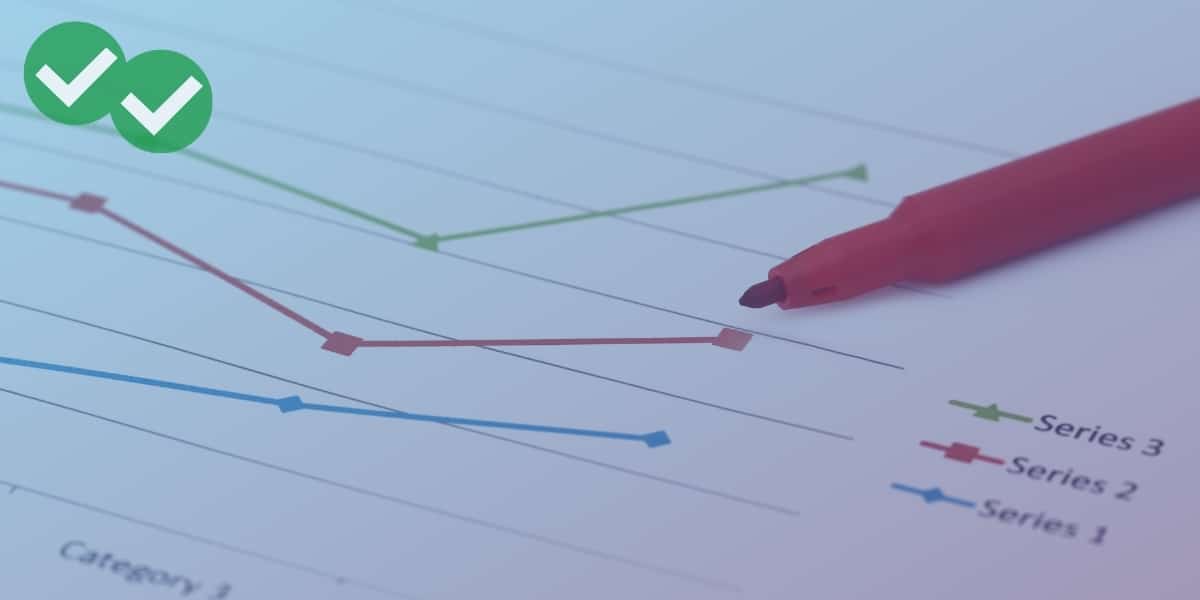
On IELTS test day, you may encounter line graphs in the Academic Writing Task 1 section. To help you understand what components make up a good response to a line graph question, let’s take a look at a model band 9 essay .
To see why this essay is band 9, see our scorer commentary after the model essay below, and check out the official IELTS rubric for Task 1 (PDF) .
This particular prompt is a line graph. Your approach to this graph should be the same as your approach to any other Task 1 infographic Take a look at the information and think carefully. What is the best way to summarize the way the information is structured and the main points? From there, how can you best compare the most relevant pieces of information? Finally, how should you structure that summary and comparison? For more advice on how to approach this, see our article on IELTS Academic Task 1 paragraph structure , as well as our main page for IELTS sample questions and practice resources .
Try to do this prompt yourself. Then check out our band 9 model essay below the prompt and compare it to your own work to see how you did.
Model IELTS Academic Writing Task 1 Prompt: Line Graph
The chart below gives information about population growth in three major Australian cities from 1992 to 2016.
Summarise the information by selecting and reporting the main features and make comparisons where relevant.
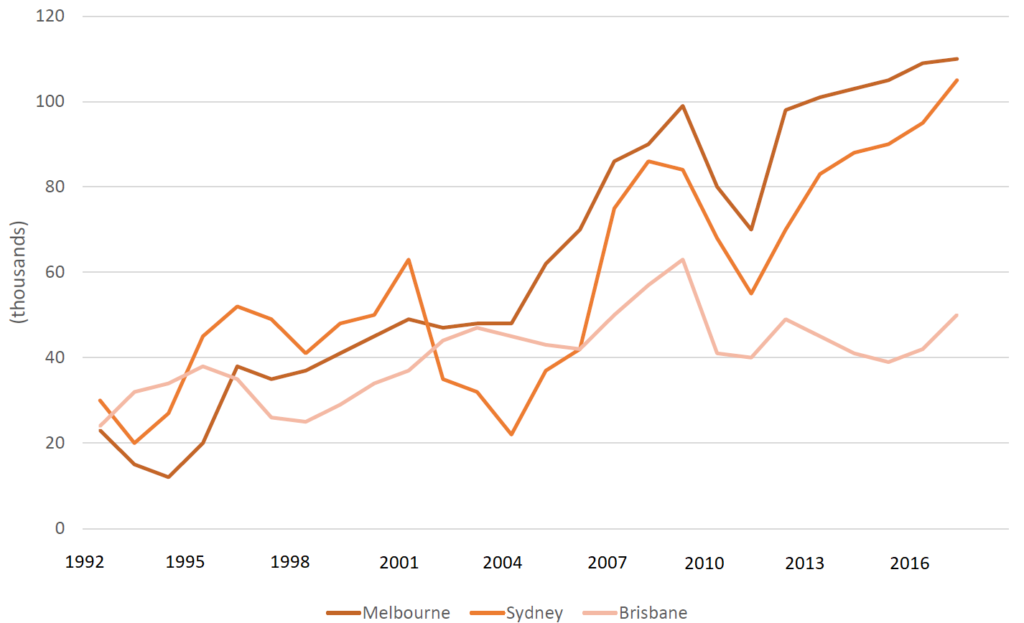
Model Essay
This line graph shows the change in population for the cities of Melbourne, Sydney, and Brisbane from 1992 to 2017.
While all cities saw a net increase in annual population growth by 2011, the most dramatic increases happened between 2007 and 2010. In spite of this overall trend, there were a number of rises and falls in growth, with all cities showing a decrease in growth in 2011.
Although it started out with the least annual growth, Melbourne’s growth accelerated the most overall, starting with only a roughly 23k increase in people in 1992, but gaining around 110,000 people in 2017. Brisbane started out with nearly as little growth as Melbourne, but had a lower net gain, rising from slightly over 23k growth in 1992 to a gain of merely 50,000 by 2017. Sydney started out with the highest growth rate at 30,000 in a year, but ended with 105,000 annual growth by the end of the period, just behind Melbourne.
Why does this essay have a band 9 score?
All of Magoosh’s model IELTS Academic Writing Task 1 essays are meant to be band 9. But this model essay is special. Here, we’re going to give you a detailed explanation as to why this is a band 9 essay! Our scoring rationale is based on the band 9 category descriptors in the official rubric for Writing Task 1 .
Task achievement
Per the instructions, this essay summarizes the information by identifying the main features in paragraph one, reporting the general content of the main features in paragraph two, and making relevant comparisons between the cities in the graph in paragraph three. This matches the band 9 descriptor “fully satisfies all the requirements of the task.
The essay organizes its paragraphs clearly, identifying the characteristics of the graph in the first paragraph, reporting the main features in the second, and making comparisons in the third. Each paragraph’s ideas are connected with appropriate linking words, such as “while,” “in spite of,” “although,” and so on. This matches with “clearly presents a fully developed response” in the band 9 task achievement section.
Coherence and cohesion
Coherence and cohesion are tied closely to the points I mentioned above in task achievement. This essay organizes similar ideas closely together in paragraphs without any distracting less relevant details and uses natural-sounding transitions. In doing this, the essay “uses cohesion in such a way that it attracts no attention” and “skillfully manages paragraphing.”
Lexical resource
While this essay does repeat sum specialized terms related to the graph, such as “annual,” it uses a variety of language to describe the same thing when possible. As one example, when describing the beginning point on the graph for each of the three cities in the final paragraph, the essay uses the terms “started out,” “began,” and “initially had.” The means that the essay “uses a wide range of vocabulary,” per level 9 of the rubric.
Not only are the words varied, but they are also very suited to the context and meaning. For instance, sophisticated phrasing such as “net increase” and “the most dramatic increases” appear in paragraph 1. Overly wordy terms such as “the total increase for each year combined” are avoided for the most part. So are slightly awkward-sounding phrases like “the very shocking increases.”
Moreover, the mistakes in word use that do appear in the essay are minor. “Amounts of people” in the first paragraph is overly simple and slightly awkward, but the essay uses the much better term “population” after that initial slip. Similarly, the use of the term “trending” when “trends” would be a more commonly used word with more accurate meaning, is a very minor word form error.
Ultimately, this links to the rubric’s description of “very natural and sophisticated control of lexical features,” where “rare minor errors occur only as “slips.”
Grammatical range and accuracy
This essay shows a level of grammar variety that’s comparable to its variety of vocabulary. The first paragraph consists of a sentence with a relatively simple structure, but with a sophisticated prepositional phrase modifying the noun “change.” The paragraphs that follow have compound sentences (the first sentence of paragraph 2), and the use of a variety of modifying phrases (ex: “with all cities…”, “rising from slightly…”).
There is a minor error in parallel structure in the first sentence of the second paragraph, with a shift from present participle “starting” to past tense “gained.” Together, these aspects of grammar in the essay satisfy the level 9 rubric descriptor “uses a wide range of structures with full flexibility and accuracy; rare minor errors occur only as ‘slips’.”
More Practice IELTS Academic Writing Task 1 Sample Questions and Model Essays
- IELTS Academic Writing Task 1: Process Diagram with Model Answer
- IELTS Academic Writing Task 1: Bar Chart With Model Answer
- IELTS Academic Writing Task 1: Map With Model Answer
- IELTS Academic Writing Task 1: Pie Chart with Model Answer
- IELTS Academic Writing Task 1: Comparing two Graphics with Model Answer

David is a Test Prep Expert for Magoosh TOEFL and IELTS. Additionally, he’s helped students with TOEIC, PET, FCE, BULATS, Eiken, SAT, ACT, GRE, and GMAT. David has a BS from the University of Wisconsin-Eau Claire and an MA from the University of Wisconsin-River Falls. His work at Magoosh has been cited in many scholarly articles , his Master’s Thesis is featured on the Reading with Pictures website, and he’s presented at the WITESOL (link to PDF) and NAFSA conferences. David has taught K-12 ESL in South Korea as well as undergraduate English and MBA-level business English at American universities. He has also trained English teachers in America, Italy, and Peru. Come join David and the Magoosh team on Youtube , Facebook , and Instagram , or connect with him via LinkedIn !
View all posts
More from Magoosh

6 responses to “IELTS Academic Writing Task 1: Line Graph with Model Answer (Band 9)”
the numbers you wrote in the essay do not tally with the diagram
Thanks for writing! The essay uses the year 2017 because the graph seems to go beyond 2016. It also uses estimation, which will be necessary in some cases, like this, where the graph does not provide exact numbers and must be interpreted/estimated.
Hope this helps! 😀
“”While all cities saw a net increase in annual population growth by 2011, and the most dramatic increases happened between 2007 and 2010. “”
Wonderful train wreck of a sentence there to start your 2nd paragraph. Don’t you guys proofread your posts?
The key features highlighted in the overview are not even mentioned in the BPs.
We get starting and ending points in the BPs with no description of the middle. This is called “mechanical” reporting and closer to a 5 than a 9.
Thanks for pointing out the typo “and” to us–we really appreciate it! I’ll get that fixed up right away!
Note that we go through the scoring towards the end of this article, and we still stand by that.
Thank you! 😀
How this is a band 9 report if there is no Overview paragraph ?
The first paragraph in this essay is “This line graph shows the change in population for the cities of Melbourne, Sydney, and Brisbane from 1992 to 2017.” While this is only one sentence, it does clearly and accurately summarize the information by identifying the main features, which is what the Task asks students to do.
Happy studying! 🙂

Leave a Reply Cancel reply
Your email address will not be published. Required fields are marked *
- IELTS Scores
- Life Skills Test
- Find a Test Centre
- Alternatives to IELTS
- General Training
- Academic Word List
- Topic Vocabulary
- Collocation
- Phrasal Verbs
- Writing eBooks
- Reading eBook
- All eBooks & Courses
- Sample Graphs
- Line Graph Examples
IELTS Line Graph Examples
Continuing with the sites IELTS line graph examples, this is an example of a line graph comparing car theft.
It's important to organise your graph clearly, draw out the key trends and make comparisons.
That has been done well in this answer.
You should spend about 20 minutes on this task.
The line graph shows thefts per thousand vehicles in four countries between 1990 and 1999.
Summarize the information by selecting and reporting the main features and make comparisons where relevant.
Write at least 150 words.
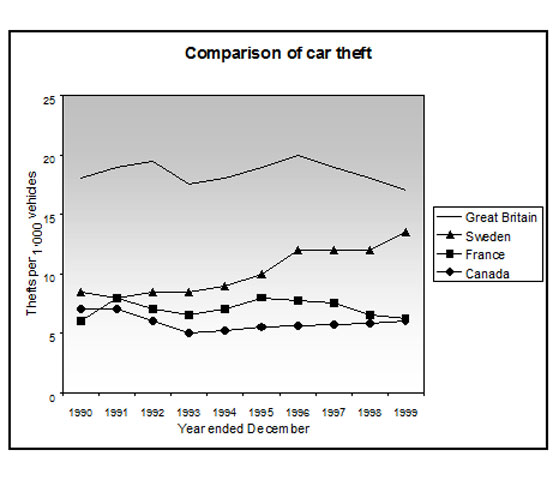
IELTS Line Graph Examples - Model Answer
The line graph compares the number of cars stolen for every 1000 vehicles in four countries from 1990 to 1999. Overall, it can be seen that car thefts were far higher in Great Britain than in the other three counties throughout the whole time frame.
To begin, car thefts in Sweden, France and Canada followed a fairly similar pattern over the first five years, all remaining at between 5 and 10 per thousand. The general trend though for France and Canada was a decline in the number of vehicles stolen over the period, with both at around 6 in 1999. In contrast, Sweden experienced an upward trend, starting the period at approximately 8, and finishing at just under 15.
Interestingly, car thefts in Great Britain started at 18 per thousand, which far exceeded that of the other countries. It then fluctuated over the next nine years, reaching a peak of 20 thefts per 1000 in 1996, and ending the period slightly lower than where it began, at approximately 17 per thousand.
(Words 174)
This graph would score highly in the IELTS test.
The graph starts with an overview that highlights the key information presented in the graph.
It has also been organised very clearly around the main trends.
The first body paragraph describes Sweden, France and Canada together as they follow a very similar pattern, whereas Great Britain is discussed separately in the second body paragraph as this follows a very different pattern.
This makes the description easy to follow and read and shows the writer has been able to make comparisons of the data.
There is also a good range of vocabulary and accurate grammar.
<<< Back
Next >>>
More on IELTS Line Graphs:
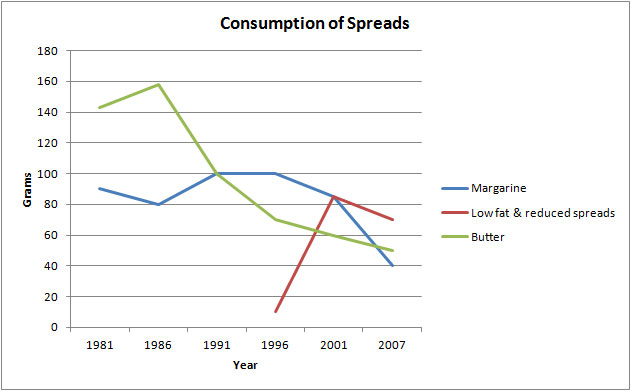
IELTS Line Graph Worksheet: Practice the language of change
IELTS Line Graph Worksheet - this is a gap fill to help you practice the language of change for IELTS graphs over time.
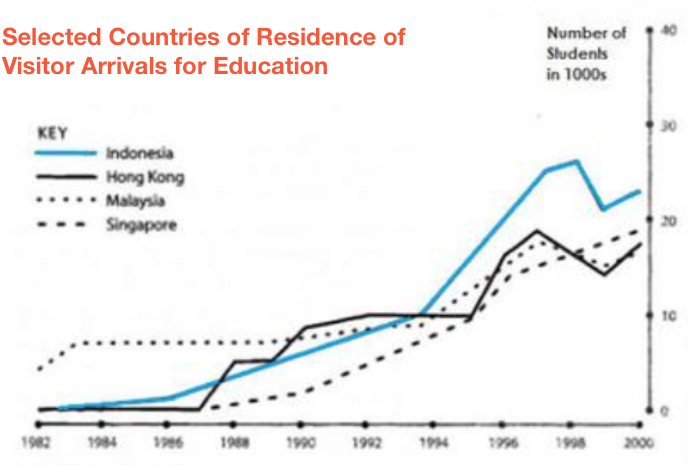
IELTS Sample Line Graph
This is an IELTS Sample Line Graph with model answer that you can use to help you prepare to write your answer for a task 1 that describes changes over time.
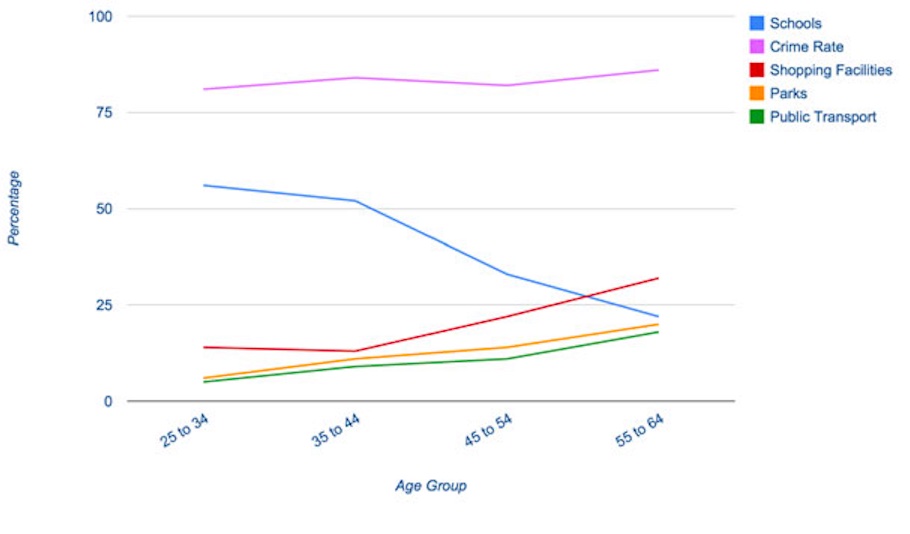
IELTS Task 1 Line Graph Structure Using Groups
For an IELTS Task 1 Line Graph there are different ways to organise your answer. Grouping information is a good way to get a logically structured response.

Line Graph Quiz
Line Graph Quiz: Have a go at this fun quiz to help you find out what you know about graphs and to help you improve your IELTS score.
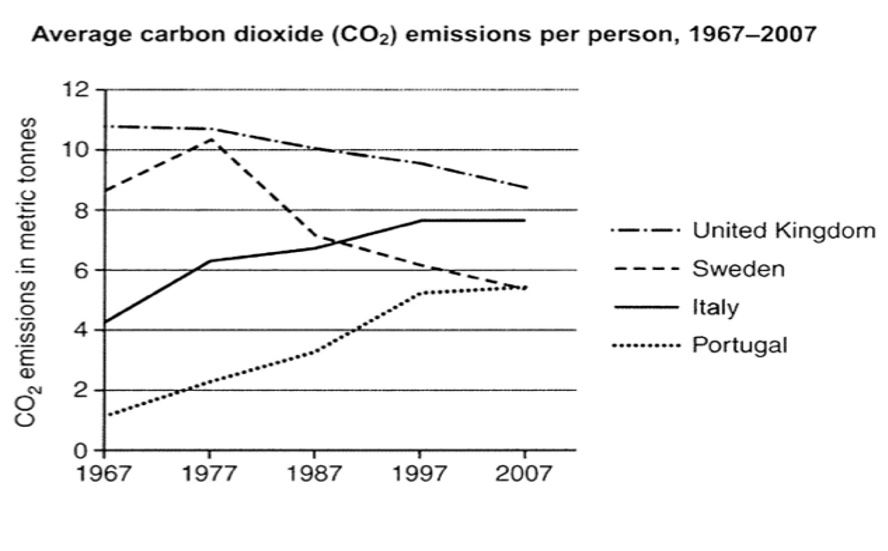
IELTS Line Graph Sample Answer: Average carbon dioxide (Co2) emissions
View an IELTS line graph sample answer that would score highly in the exam. It's well organised and covers all the requirements of the task.
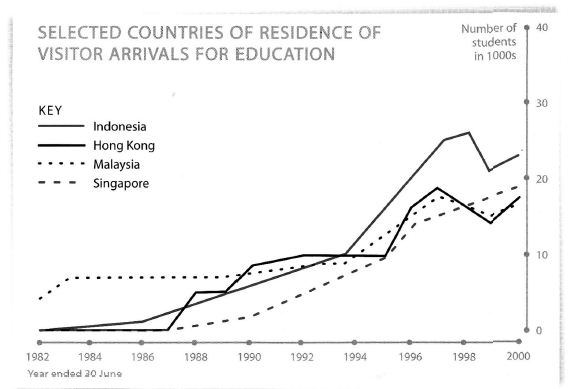
Tips for Organising an IELTS Line Graph
Organising an IELTS Line Graph - This lesson shows you have to improve the coherency of your graph in order to achieve a high band score.
Any comments or questions about this page or about IELTS? Post them here. Your email will not be published or shared.
Before you go...
Check out the ielts buddy band 7+ ebooks & courses.

Would you prefer to share this page with others by linking to it?
- Click on the HTML link code below.
- Copy and paste it, adding a note of your own, into your blog, a Web page, forums, a blog comment, your Facebook account, or anywhere that someone would find this page valuable.
Band 7+ eBooks
"I think these eBooks are FANTASTIC!!! I know that's not academic language, but it's the truth!"
Linda, from Italy, Scored Band 7.5

IELTS Modules:
Other resources:.
- All Lessons
- Band Score Calculator
- Writing Feedback
- Speaking Feedback
- Teacher Resources
- Free Downloads
- Recent Essay Exam Questions
- Books for IELTS Prep
- Useful Links

Recent Articles
Paraphrasing in the IELTS Test: Speaking and Writing
May 03, 24 10:26 AM
Fillers for IELTS Speaking: Avoid 'Eh', Uhm', 'You know'.
Apr 27, 24 05:48 AM
Decreasing House Sizes Essay
Apr 06, 24 10:22 AM

Important pages
IELTS Writing IELTS Speaking IELTS Listening IELTS Reading All Lessons Vocabulary Academic Task 1 Academic Task 2 Practice Tests
Connect with us
Copyright © 2022- IELTSbuddy All Rights Reserved
IELTS is a registered trademark of University of Cambridge, the British Council, and IDP Education Australia. This site and its owners are not affiliated, approved or endorsed by the University of Cambridge ESOL, the British Council, and IDP Education Australia.
- Skip to primary navigation
- Skip to main content
- Skip to primary sidebar
- Skip to footer

IELTS Advantage
IELTS Preparation Courses
IELTS Bar Chart Sample Essay
Static or Dynamic?
Before writing an IELTS task 1 bar chart or line graph answer it is important that we analyse the question correctly. Taking a few minutes to do this will help us write a clear answer that fully responds to the question. Just what the examiner wants us to do.
The first thing we need to do is decide if the bar chart is static or dynamic. Static means that the data comes from one point in time. Dynamic means the data comes from more than one point in time.
Whether a chart is static or dynamic will affect the information we choose to include in our answer and the kind of language (tense, grammar etc.) we use.
If it is dynamic we will have to compare the different times and comment on the general trends over the time period.
If it is static we will have to compare the different variables, in this case countries, car price, GDP and time it takes for one person to buy a car.
Main Features
Every IELTS academic task 1 question asks us to ‘select and report the main features’.
This means that we have to not only pick the most significant information from the graph and include it in our essay, but also decide which information is not important and should therefore not be included in our essay. One of the biggest mistakes you can make in task 1 is including all the information you see.
So which information should you choose?
You should look for:
- highest/lowest values
- biggest differences
- similarities
- significant exceptions
- anything else that really stands out
There are 3 main features in this graph
1) It takes over 26 years for a Vietnamese person to buy a car.
2) Vietnam has the second highest average costs but the second lowest wages.
3) Cost of a car in Singapore is nearly 3 times the next most expensive.
I advise my students to follow a basic four paragraph structure for these kinds of questions.
Paragraph 1
Paraphrase the question using synonyms.
Paragraph 2
Provide an overview of the main features. No need to include any data in this paragraph, just tell the examiner what is happening in general terms. If you had to describe the main features in two sentences, what would you say?
Paragraph 3
This is where we get more specific and use data. Take 2 of the main features (from your overview) and describe them in detail using data from the chart.
Paragraph 4
Simply do the same thing as you did in paragraph 3, but with two other main features (from your overview).
Sample Answer
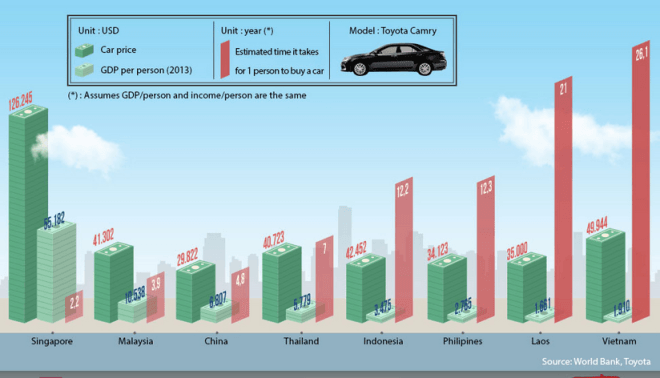
The graph compares the GDP per capita, cost of a Toyota Camry and approximate length of time it takes for 1 citizen to purchase that mode of transport in eight Asian countries.
Despite having the second lowest average yearly income, it costs more to buy this car in Vietnam than in all but one other Asian nation. It also takes significantly longer for a standard person to buy an automobile in Vietnam than in any other state in Asia. On the other end of the scale, Singaporeans have to pay nearly three times more for their cars than the Vietnamese and it takes them the least amount of time to afford a motor vehicle.
It costs $49,944 to buy a Toyota Camry in Vietnam, but this dwarfs the average yearly income per person at just $1,910. It would therefore take a normal man or woman 26.1 years to save up for that particular car.
This is in contrast to Singapore where it costs $126,245 for that model of motorcar, however the average salary is much greater at $55,182. This means that it generally takes just over 2 years for a typical individual from Singapore to acquire this vehicle.
(200 words) Band 9.
It should be noted that this is not a real IELTS task 1 question. This is just a chart that I saw on the internet, but it allowed me to make a very important point- you don’t have to mention everything on the graph. I only talked about 2 out of the 8 countries and I still wrote 200 words and answer the question fully. The key is finding the most significant data and not talking about anything else. Don’t worry, you won’t lose marks for not talking about everything, quite the opposite.
This graph is also good for demonstrating how important it is to vary your vocabulary. There were four words that could have been overused in this essay- car, average, country and people. Instead of repeating them over and over again I used synonyms to show the examiner I have a wide vocabulary and gain extra marks. Here are the synonyms:
Car- Toyota Camry- automobile- vehicle- motor vehicle- motorcar
Average- approximate- normal- typical- standard
Country- countries- nation- state
People- citizen- man or woman- individual
Next time you see a chart or graph in a newspaper, in a textbook or on the internet, think about what the main features are and what common words would you have to vary with synonyms.
I hope you have found these tips useful. If you have any questions, let me know below.
For more band 9 sample essays check out our task 1 sample essay page.
About Christopher Pell
My name is Christopher Pell and I'm the Managing Director of IELTS Advantage.
I started IELTS Advantage as a simple blog to help 16 students in my class. Several years later, I am very humbled that my VIP Course has been able to help thousands of people around the world to score a Band 7+ in their IELTS tests.
If you need my help with your IELTS preparation, you can send me an email using the contact us page.

Press ESC to close

IELTS Writing Task 1 Line Graph Examples: Here’s a Guide to Master the IELTS Essays
One of the most popular essay topics in the IELTS writing task 1 is explaining the line graph. This is a type of essay where you will have to explain the data given in the form of line graphs. This task is particular to the academic writing and the general candidates need not worry about this.
As you must know that the IELTS writing task 1 line graph is the shorter of the two tasks and needs to be written in 150 words at least. It is also necessary that you finish this task in no more than 20 minutes, as the second task is lengthier and as such, requires more time. Let us get into the details of line graph essays.
Skills Tested in IELTS Task 1
In IELTS writing task 1, you will be asked to describe facts or figures presented in one or more graphs, charts or tables on a related topic; or they may be given a diagram of a machine, a device or a process and asked to explain how it works.
Important Points
You must write in an academic or semi-formal/ neutral style and include the most important and the most relevant points in the diagram.
This task assesses your ability to identify the most important and relevant information and trends in a graph, chart, table or diagram, and to give a well-organised overview of it using language accurately in an academic style.
You will also be judged on how appropriately, accurately and relevantly the response fulfils the requirements set out in the task, using the minimum of 150 words.
Further Assessment
- You will be assessed on how your response organises and links information, ideas and language with appropriate use of cohesive devices (for example, logical connectors, pronouns and conjunctions) to assist in making the conceptual and referential relationships between and within sentences clear.
- You will also be judged on your use of a range of vocabulary and grammatical devices and its accuracy in terms of the specific task.
How to Structure IELTS Writing Task 1 Line Graph Essays?
Structuring a line graph essay is not a big deal. All you need to remember is that you do not need a conclusion here. As this isn’t a discursive essay, so conclusions do not serve any purpose. Here is an IELTS sample essay to know how you can structure a line graph essay:
Paragraph 1 (Introduction)
- Sentence 1- Paraphrase Question
This paragraph should be one sentence long and demonstrates your ability to paraphrase. You should do this by using synonyms.
Paragraph 2 (Overview)
- Sentence 1- Overview of the first main feature
- Sentence 2- Overview of the second main feature
- Sentence 3- Make general comparison, if appropriate
An overview is a general statement, highlighting the most important information in the table. It should not include any numbers. This is just a summary of the main features. You can use numbers to support your answer in paragraphs 3 and 4.
The examiner is testing your ability to identify the most important information and then summarise it. Important information could include general trends, increase/ decreases, differences, comparisons etc.
Paragraph 3 (Details of significant feature 1)
- Sentence 1- Supporting details
- Sentence 2- Supporting details
- Sentence 3- Supporting details/ comparison details, if appropriate
In this paragraph, you take the first general statement from paragraph 2 and support it with details from the graph. The examiner is looking for your ability to choose the correct data and ability to describe data, trends, comparisons etc.
You then repeat this process for paragraph 4, only this time you describe the second sentence in paragraph 2.
Paragraph 4 (Details of significant feature 2)
There may also be three significant features, in which case you can adjust the structure slightly.
You must remember not to write a conclusion. Conclusions are for opinion or discursive essays and you are not expected to do this in task 1.
Also Read : 9 Practical IELTS Letter Writing Tips: Guide to General & Academic Writing
IELTS Writing Task 1 Line Graph Example Essay Question

Source: Cambridge English IELTS Past Papers.
The IELTS writing task 1 line graph gives information from a 2008 report about the consumption of energy in the USA since 1980 with projections until 2030.
Summarise the information by selecting and reporting the main features, and making comparisons where relevant.
IELTS Sample Essays Answer
The line graph shows energy consumption by fuel type in the United States from 1980-2008, with projected use until 2030.
Overall, fossil fuels have been the dominant type and will continue this trend into the future. Nuclear and renewable energy sources have represented a small but significant proportion of total energy use and despite small projected gains; it is projected that they will continue doing so.
Main Information
Petrol and Oil commanded the biggest share with 35 quadrillion units (35q) in 1980, rising to approximately 40q in 2008 and this trend is set to continue with a projected value of nearly 50q in 2030. In 1980 natural gas and coal came in second and third, with around 16q and 20q respectively. However, coal overtook natural gas in 1990 and despite some fluctuation, is set to be the second most used fuel in 2030 with just over 30q. It is predicted that natural gas will level off and remain relatively constant at about 25q.
Nuclear and the renewable energies all represented around 4q in 1980 and fluctuated up until 2008. It is speculated that nuclear energy will reach 10q by 2030 and solar/wind around 5q, with hydropower dropping and then remaining constant at approximately 2q.
Academic writing task 1 is a writing task which has a defined input and a largely predictable output. It is basically an information-transfer task that relates narrowly to the factual content of an input diagram and not to speculative explanations that lie outside the given data.
You can take help of any good IELTS online training programs for enhancing your skills in this topic. A proper IELTS online preparation will help you with the most important part and that is choosing the correct information. If you know what to put into the essay and have a concrete structure, you are absolutely good to go!
Also Read : Duolingo Test Scores Explained: Comparison with IELTS and TOEFL

One Comment
I was looking for this article for the preparation of graphs and how to write essays, this was very useful, what are you looking for?
Leave a Reply Cancel reply

Share Article:
About the Author
Indulekha prabha.
My name is Indulekha Prabha. I am an English teacher and a content writer by profession. When I'm not working you can find me writing fiction, reading poetry and painting.
You might also like

Describe Something Important that has been Kept in Your Family: A Cue Card Sample Topic for IELTS Speaking

How to Use an IELTS Calculator? Calculate Your Overall IELTS Exam Score

What is a Good IELTS Score? Is 7.5 a Good IELTS Score? Here’s All You Need to Know
Other stories, top ielts classes in ambala: all you need to know to score better, how to sound more confident in the ielts speaking test effective speaking practice guide.
Study Abroad
Scholarships
IELTS Writing Task 1: Pie Chart
Updated on Mar 08, 2024, 10:52
IELTS Writing Task 1 encompasses different types of visual data, including a pie chart. Pie charts are easy to analyse; most of you would have learned about them in school!
However, writing a description/report that meets IELTS Writing standards is challenging. That’s where we come in.
On this page, we’ll explore various strategies that can be used to solve IELTS Writing Pie Chart question types and provide you with samples for better understanding.
On This Page

1. IELTS Writing Pie Chart Task 1: Sample Answer
You can quickly climb the learning curve by practising regularly and referring to sample answers!

2. IELTS Writing Pie Chart Task 1: How to Answer
Pie charts contain a circular chart comprising various divisions representing a value.
More for you
Boost your IELTS Writing score
See how to score 8+ in Listening.
Get proven strategies to ace your IELTS Listening test.
IELTS Writing Pie Chart Task 1: Sample Answer
You can quickly climb the learning curve by practising regularly and referring to sample answers!
Pro tip: Remember, IELTS hates memorised answers. Try only to take inspiration from our samples and practice writing it yourself.
Let’s see a sample answer for Pie Chart Task 1.
- The charts show projections for global production by sector in 2040 and 2060 .
- Summarise the information by selecting and reporting the main features and make comparisons where relevant.
Sample Answer:
The pie charts provide a comprehensive overview of the projections for global production by sector from 2040 to 2060. Remarkably, the service sector dominates both pie charts holding the highest segment, whereas the agriculture sector remains the smallest in both the years.
By observing the pie charts, it can be inferred that the manufacturing sector will rise from 31% in 2040 to 33% in 2060. The service sector will increase by 1% from 40% in 2040 to 41% in 2060. In contrast, agriculture production will decline by 3% from 4% in 2040 to 1% in 2060.
Moreover, the Material and Info-Com Tech sectors will rise from 3% and 15% in 2040 to 4% and 16% in 2060, increasing by 1%, respectively. The energy sector will decline from 7% in 2040 to 5% in 2060.
Overall, no significant changes have been predicted. Though all the sectors have their importance, the service sector has the highest manufacturing projection in 2060.
IELTS Writing Pie Chart Task 1: How to Answer
Pie charts are named after their shape, as they look like a delicious pie! These charts contain a circular chart comprising various divisions representing a value.
As a part of IELTS Writing Task 1, you must analyse the chart and respond to the given questions. Here’s how you can go about it.
Analyse the Question
Read the question thoroughly. Understand what each value represents. The question may ask you to summarise the information, write about the main features, or compare the main features.
Here’s an example of the same:
- The pie chart shows the proportion of different categories of families living in poverty in the UK in 2002.
It’s essential to pay attention and directly respond to exactly what’s asked in the question. Try not to go overboard with your answers. Pick 2-3 that stands out when you talk about main features. Don’t attempt to cover everything.
Identify the Main Features
How do you spot the main features? You can think of the main features as the things that naturally stand out from the graph. It could be a common and consistent trend or pattern, units of measurement, or even the graph's labels.
For instance, if the chart concerns people living in poverty, can you spot which category has the highest and lowest poverty rate? These could easily be your main features!
The main features will differ from one chart to another. Try to keep it simple; don’t get too mathematical. Here are some things you can do:
- Read through the labels and titles carefully
- Examine the proportions of each division
- Identify the highest and lowest proportions
- Check if the chart has a pattern or trend
- Conduct a quick comparison of the elements
Structure your Report/Description
Once you have figured out the fundamentals of your chart, structure your essay. Here’s the most classic structure for any writing piece:
- Introduction: Start with a simple paraphrase of your question. You could say, “The chart above depicts the proportion of different categories of families living in poverty in the UK in 2002.”
- Overview: Highlight the main features in the text and write a small description about each of them.
- Dive into the details: Expand the main features and get into the details. Write about the whys, whats, and hows. Quote the percentages in the pie chart to support your information. You can apply this to two paragraphs of the body of your essay.
- Provide comparison: If the question asks you to compare data, this is where you can compare the main elements of the graph. Try to do it sequentially, and try not to take sides. You can use words like “In contrast,” “Similarly,” or “On the other hand” to establish a comparison.
- Conclude: Summarise your deductions from the chart and make any final recommendations, if necessary.
Below is a sample for your better understanding!
IELTS Writing Task 1: Bar Graph
IELTS Writing Task 1: Diagram
IELTS Writing Task 1: Line Graph
IELTS Writing Task 1: Table Chart
IELTS Writing Task 1: Map
IELTS Writing Practice Test
IELTS Important Information
IELTS Exam Date
IELTS Exam Fee
IELTS Modules
IELTS Listening Practice Test
IELTS Speaking Practice Test
IELTS Reading Practice Test
IELTS Test Centres
IELTS Results
Types of IELTS
IELTS Pattern
IELTS Exam Eligibilty
IELTS Slot Booking
IELTS Band Score
IELTS Registration
IELTS Books
IELTS Preparation
IELTS Practice Test
IELTS Accepting Countries
Study In USA
Study In Canada
Study In UK
Study In Australia
Study In Ireland
IELTS Accepting Universities
Massachusetts Institute Of Technology
The University Of British Columbia
Harvard University
University Of Toronto
Conestoga College
University Of East London
Stanford University
University Of Alberta
Coventry University
New York University
Read More about IELTS Practice Test
IELTS Speaking Cue Card
IELTS Speaking Part 1
IELTS Writing Task 1
IELTS Writing Task 2
Task 1 Pie Chart
Task 1 Table Chart
Task 1 Bar Graph
Task 1 Line Graph
Task 1 Diagram
IELTS Test Centre and Dates in India
IELTS Test Centre and Dates in Hyderabad
IELTS Test Centre and Dates in Bangalore
IELTS Test Centre and Dates in Chennai
IELTS Test Centre and Dates in Amritsar
IELTS Centre and Dates in Ludhiana
IELTS Test Centre and Dates in Mumbai
IELTS Test Centres and Dates in Ahmedabad
IELTS Centre and Dates in Delhi
IELTS Test Centres and Dates in Chandigarh
IELTS Center and Dates in Pune
Related Articles
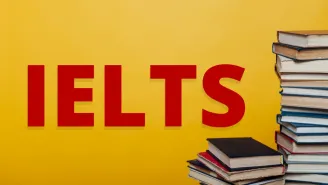
Q. How to analyse a pie chart?
A. The best way to analyse a pie chart is as follows:
- Analyse the key elements, such as the highest and lowest proportions
- Look for patterns. Is there a common trend?
- Pay attention to the label and numbers mentioned.
Q. How should I structure my essay for a Task 1 Pie Chart Question?
A. You should ideally divide the essay into 3 parts, introduction, body and conclusion. Here’s how to go about it.
- Introduction: Paraphrase the given question
- Body: Highlight the main features of the text, and highlight descriptions of each text
- Conclusion: summarise and make any final recommendations, if necessary
Q. Do I need to include all the data from the pie chart in my essay?
A. No, you don't need to include every detail from the chart. In fact, it is recommended that you don’t cover each and every detail from the chart as it may unnecessarily expand your answers. Focus on the most significant trends and comparisons, and use those to support your analysis. But, make sure you’re covering all the important points.
Q. How long should my essay be for a Task 1 Pie Chart Question?
A. Typically, IELTS writing task 2 questions should be 250-300 words long. The question will specify the required word count. You must make sure that your answer is not shorter than the given minimum word limit, or you may lose marks. However, you can freely exceed the word count if necessary. Try not to make your essay too lengthy.
Q. What kind of vocabulary should I use in my essay for Task 1 Pie Chart Questions?
A. Here are some useful words to use in Pie Chart questions of writing task 2:
- Proportion
- Trend
- Distribution
- Comparison

IELTS Writing Task 1 – Line Graph Essay Example 2
In this post, we will look at a Writing Task 1 Academic line graph essay example from the IELTS writing task 1 Academic Test. Students often ask if the questions are repeated year after year and the answer is no, but the type of chart or graph can be.
There are so many questions written each year, you may find you practice answering various questions on different topics. It is best practice to learn how to answer each one of the various types of writing task 1 questions , from bar charts, line graphs, maps, process etc.
If you would like to learn how to structure a charts and graphs essay please click the button below >
Take a look at the IELTS Writing Task 1 Academic essay example below >>
*This line graph question and answer were provided by a student. IELTS Achieve did not design this question*
The graph gives information about the number of spreads (Margarine, low fat & reduced spread and butter) consumed from the year 1981 up to 2007. The units were measured in grams.
Overall, the highest consumed spread was butter which started as the most used among the three, whereas low fat and reduced spread were only introduced in 1996, however, all three spreads fluctuated within the end of the given time frame.
On the one hand, butter started strong with 140 grams consumed in the year 1981 but gradually decreased as the years progressed until it plummeted to nearly 50 grams used by 2007. Similarly, this can be seen in margarine with almost 90 grams used in 1981 then it slowly decreased in 1986. It reached a plateau in 1991 up to 1996 and gradually decreased reaching 40 grams used in 2007.
On the other hand, low fat & reduced spread was introduced in 1996. It gently rose from almost 10 grams used when it started then progressively increased reaching its highest peak in 2001 (80 grams) however like the two other spreads it slowly decreased up until 2007 were it garnered almost 60 grams.
Word count – 194 / Band score – 8

- Task Achievement – The answer provides a paraphrased question, to begin with, followed by an overview that gives the reader key information.
- Coherence and Cohesion – The answer has been divided into clear logical paragraphs.
- Lexical Resource – There is evidence of paraphrasing, synonyms and some less common words.
- Grammatical Range and Accuracy – The answer has no grammatical errors. The sentences are mainly made up of multiple clauses and have a variety of structures.
We hope you found this post useful in helping you to study for the IELTS Test . If you have any questions please let us know in the comments below or on the Facebook page.
The best way to keep up to date with posts like this is to like us on Facebook , then follow us on Instagram and Pinterest . If you need help preparing for the IELTS Test, join the IELTS Achieve Academy and see how we can assist you to achieve your desired band score. We offer an essay correction service, mock exams and online courses.
Related Posts
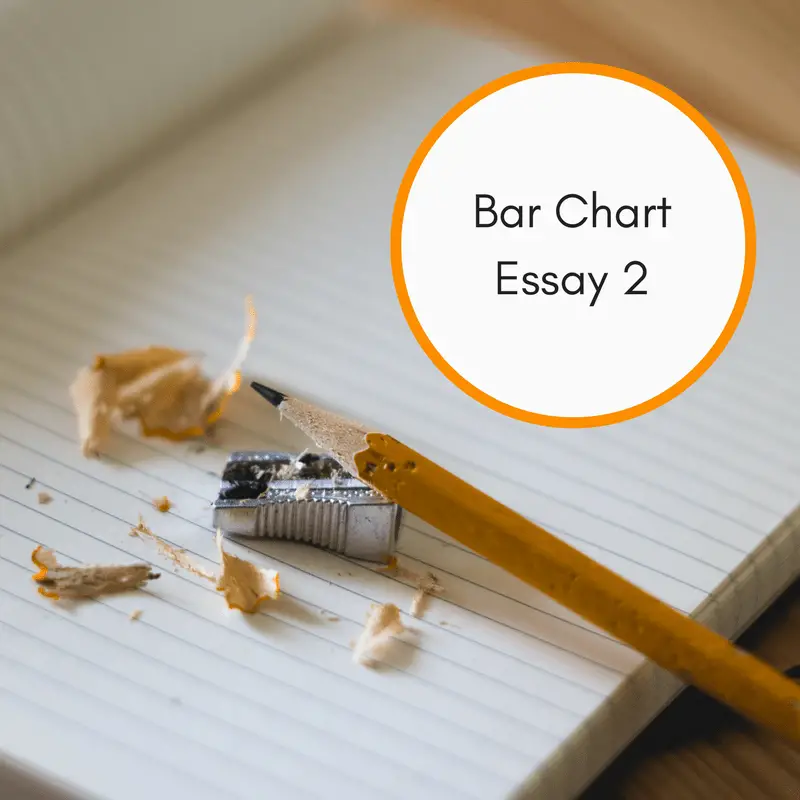
IELTS Writing Task 1 – Bar Chart Example Essay – 2
IELTS Writing Task 1 Academic bar chart essay example that is a band score 8.…
A few problems have emerged in your apartment: Semi-Formal Letter [IELTS General Writing Task 1 ]
You should spend about 20 minutes on this task. You have been living in an apartment for…
1 thought on “IELTS Writing Task 1 – Line Graph Essay Example 2”
Thanks for finally talking about >IELTS Writing Task 1 – Line Graph Essay Example 2 – IELTS ACHIEVE <Loved it!
Leave a Comment Cancel Reply
Your email address will not be published. Required fields are marked *
Save my name, email, and website in this browser for the next time I comment.
IELTS Mentor "IELTS Preparation & Sample Answer"
- Skip to content
- Jump to main navigation and login
Nav view search
- IELTS Sample
IELTS Writing Task 2/ Essay Topics with sample answer.
Ielts essay # 1511 - newspapers are the best way to learn about current events, ielts writing task 2/ ielts essay:, some people think that newspapers are the best way to learn about current events. however, others believe that they can learn news better through other media., discuss both these views and give your opinion..
- IELTS Essay
- IELTS Writing Task 2
- IELTS Essay Sample
- Discuss both views
IELTS Materials
- IELTS Bar Graph
- IELTS Line Graph
- IELTS Table Chart
- IELTS Flow Chart
- IELTS Pie Chart
- IELTS Letter Writing
- Academic Reading
Useful Links
- IELTS Secrets
- Band Score Calculator
- Exam Specific Tips
- Useful Websites
- IELTS Preparation Tips
- Academic Reading Tips
- Academic Writing Tips
- GT Writing Tips
- Listening Tips
- Speaking Tips
- IELTS Grammar Review
- IELTS Vocabulary
- IELTS Cue Cards
- IELTS Life Skills
- Letter Types

- Privacy Policy
- Cookie Policy
- Copyright Notice
- HTML Sitemap

IMAGES
VIDEO
COMMENTS
A sample answer to the Recent IELTS Graph 2: Question: The charts below show the growth in the population in some of the world's largest cities as well as the population distribution in urban and rural areas. Summarize the information by selecting and reporting the main features, and make comparisons where relevant.
Introduce the Graph. You need to begin with one or two sentences that state what the IELTS writing task 1 shows. To do this, paraphrase the title of the graph, making sure you put in a time frame if there is one. Here is an example for the above line graph: The line graph compares the fast food consumption of teenagers in Australia between 1975 ...
This model line graph for IELTS is estimated at band score 9. The model answer below is for IELTS writing task 1 academic paper. Use this sample writing as a template for structure, key features and language for any IELTS line graph. There are also some tips given below to guide you and help you understand how to describe this type of graph.
IELTS Academic - Graph Writing: In your IELTS Academic Writing Task 1, you will be given with one or more graph(s) (i.e. bar, column, line or pie), table, flowchart, map or process diagram and you need to summarise the main information, compare data, show contrasts and trends, identify significant trends and describe a process.You should write between 150 to 200 words and the minimum word ...
To make the best use of your time it's important to write with a clear structure, focus on the most important trend or trends, choose appropriate vocabulary and avoid common mistakes. In this tutorial, we have a band range 6.5 / 7 academic task 1 IELTS line graph example essay graded by an ex-IELTS examiner (on our team of essay correctors).
IELTS Writing Task 1 - Line Graph Essay 1. IELTS Writing Task 1 Academic line graph essay example that is a band score 8. The question is: The line graph below shows changes in the amount and type of fast food consumed by Australian teenagers from 1975 to 2000. Take a look at the sample answer.
Pay attention to the overall structure of your answer and paragraphs order; keep an eye on the main ideas and how they are supported by examples. So, let's take a look at one example of a graph description in IELTS Writing Task 1. We will analyze the examples from official materials made by the creators of IELTS. Graph 1. Bar chart
Here is the 5 steps process I recommend for planning and writing IELTS line graph essays: 1) Analyse the question. 2) Identify the main features. 3) Write an introduction. 4) Write an overview. 5) Write the details paragraphs. I'm going to take you through the whole process step-by-step as we work on a practice question.
Using IELTS Graph Vocabulary in a Model Essay. Look at the sample IELTS writing Task 1 graphs on the British Council website. Below is my model answer with useful words in bold: The bar charts illustrate the trends in computer ownership, with a further classification by level of education, from 2002 to 2010.
Writing - Graph. This section contains IELTS graph writing samples where in you can practice your writing skills and assess by constantly checking the model answers. Check out the band 9 IELTS writing task 1 sample answers academic to get a clear understanding of the type of language, flow and vocabulary used in the IELTS exam. Try them out now!
In the first part of IELTS Academic Writing, you can come across different types of graphs: a line or bar graph, a table, a map, a process, two graphs or two tables. You select words and grammatical constructions depending on the type of graph you are writing about. For example, if you got a process (e.g. water cycle on Earth) you use words ...
This collection of IELTS charts represents the main types of charts that you can be given in writing task 1, including tasks with two or three charts combined. Please remember that writing task 1 is not an essay, it is a report. Use the sample practice charts, tables and diagrams below to practise and develop your IELTS writing task 1.
In IELTS, it should be pretty obvious what you are given because the only three graph types you have are: Line graphs. Bar charts. Pie charts. However, you may have a graph that incorporates the first two or you could be given a line graph and a table, a bar chart and a pie chart, or any combination thereof.
An activity which helps students use a range of suitable lexis for describing graphs. The session can be used for IELTS preparation or for more general academic writing skills. Time required: 60-70 minutes ... verb combinations from the example sentences. After feedback on this, show the student how to make the nouns in the first table into ...
On IELTS test day, you may encounter line graphs in the Academic Writing Task 1 section. To help you understand what components make up a good response to a line graph question, let's take a look at a model band 9 essay.. To see why this essay is band 9, see our scorer commentary after the model essay below, and check out the official IELTS rubric for Task 1 (PDF).
In Academic IELTS Writing task 1, you will have one or more graphs (usually one to three) and you need to summarise the information or write a report about the data presented within 20 minutes. You are advised to write minimum 150 words and less than that would reduce your band score. Some diagrams or graphs are easy to examine and present.
Continuing with the sites IELTS line graph examples, this is an example of a line graph comparing car theft. ... In this decreasing house sizes essay for IELTS you have to discuss the pros and cons of smaller house sizes and gardens. Read More. Latest IELTS Writing Topics - Recent Exam Questions. Apr 04, 24 02:36 AM.
IELTS Writing Task 1 Academic line graph essay example that is a band score 8. The question is > The line graph below shows changes in the amount and type of fast food consumed by Australian teenagers from 1975 to 2000. Take a look at the sample answer >>
Before writing an IELTS task 1 bar chart or line graph answer it is important that we analyse the question correctly. Taking a few minutes to do this will help us write a clear answer that fully responds to the question. ... For more band 9 sample essays check out our task 1 sample essay page. About Christopher Pell. My name is Christopher Pell ...
IELTS Sample Essays Answer. The line graph shows energy consumption by fuel type in the United States from 1980-2008, with projected use until 2030. Overall, fossil fuels have been the dominant type and will continue this trend into the future. Nuclear and renewable energy sources have represented a small but significant proportion of total ...
IELTS Writing Task 1 - Pie Chart Example Essay 1. In this post, we will look at a Writing Task 1 Academic pie chart essay example from the IELTS writing task 1 Academic Test. Students often ask if the questions are repeated year after year and the answer is no, but the type of chart or graph can be. There are so many questions written each ...
On this page, we'll explore various strategies that can be used to solve IELTS Writing Pie Chart question types and provide you with samples for better understanding. 1. IELTS Writing Pie Chart Task 1: Sample Answer. You can quickly climb the learning curve by practising regularly and referring to sample answers! Read More.
IELTS Writing Task 1 - Bar Chart Example Essay 3. In this post, we will look at a Writing Task 1 Academic bar chart essay example from the IELTS writing task 1 Academic Test. Students often ask if the questions are repeated year after year and the answer is no, but the type of chart or graph can be. There are so many questions written each ...
Take a look at the IELTS Writing Task 1 Academic essay example below >>. *This line graph question and answer were provided by a student. IELTS Achieve did not design this question*. The graph gives information about the number of spreads (Margarine, low fat & reduced spread and butter) consumed from the year 1981 up to 2007.
To reiterate, although many prefer print newspapers because of their extensive reporting, this essay finds that digital news mediums are better at learning news on current affairs because of their ability to provide live coverage of breaking news events. Sample Answer 2: The debate over the most effective medium for staying informed about ...